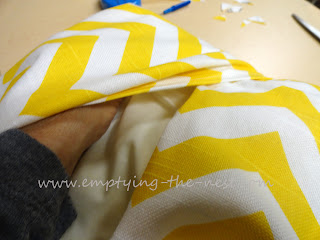Oh my! What has happened to this shirt? I can't get it over my head! The neck is too small! And even if I could, one sleeve is longer than the other one! Well, I am just disgusted! I will never try this again!
Those were my thoughts about 32 years ago after completing
my first sewing project. I guess you
could say I have come a long way since then.
I did continue sewing and even went into a profession that allows me to
teach others the joy of sewing. However,
some of my students have similar first experiences. The first thing I tell my students is that
they must have patience. You will make
many mistakes, throw half-finished projects away, and get totally frustrated. But if you hang in there and be patient you can
develop skills that can be used in many ways.
I have saved a lot of money making my own bedding , window treatments
, window treatments , and
pillows. And I have enjoyed
being able to sew for myself and my daughters. Not to mention it is a real sense of accomplishment being able to create something from fabric.
Through the years I have learned some shortcuts and sewing hints. Here
are just a few:
, and
pillows. And I have enjoyed
being able to sew for myself and my daughters. Not to mention it is a real sense of accomplishment being able to create something from fabric.
Through the years I have learned some shortcuts and sewing hints. Here
are just a few:
Patterns:
•Never pay full price for patterns. If you live close to Hancock Fabrics , they will always put them on sale sometime within the month.•Place your pattern on fabric and cut garment out at the same time you cut the pattern. This saves you one step.
•Spray a new pattern with fabric protector. The pattern will last longer, rip less easily
and resist wrinkles.
Marking Tools:
•Instead of buying sewing marking pens or pencils use leftover
old soap squares instead of throwing them away.Scissors:
- Invest in handheld scissor sharpeners.
- Fiskars scissors are a great investment.
Sharpening a machine
needle:
•Stitch through a piece of sandpaper.
Buttons and buttonholes
•Here's a tip for keeping four-hole buttons on longer. Sew through only two holes at a time, breaking the thread and knotting it for each pair of holes. This way, should one set break loose, the other side will still hold the button.
•Use dental floss or elastic thread to sew buttons on children's clothing. The buttons will take a lot of wear before falling off.
•Here's a tip for keeping four-hole buttons on longer. Sew through only two holes at a time, breaking the thread and knotting it for each pair of holes. This way, should one set break loose, the other side will still hold the button.
•Use dental floss or elastic thread to sew buttons on children's clothing. The buttons will take a lot of wear before falling off.
Sharp Corners on Collars or Pillows:
•Use large knitting needles to poke out corners. Be careful not to poke through stitching.
•Check out pillow making tutorials: DIY Pillow Form, How to Make a Decorative Pillow Cover
•Use large knitting needles to poke out corners. Be careful not to poke through stitching.
•Check out pillow making tutorials: DIY Pillow Form, How to Make a Decorative Pillow Cover






































